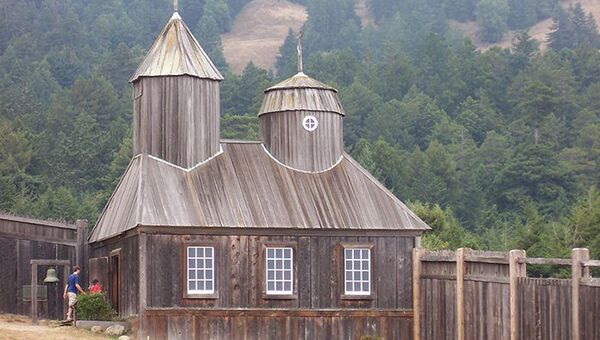WASHINGTON, June 7 (By Maria Young for RIA Novosti) – A 19th-century Russian trading outpost in California that was once the locus of a rare friendship between Russian settlers and the indigenous Kashia tribe will host a tribute this weekend to a little known piece of Russian-American history that lives on in both countries today.
In stark contrast to tales of violence and bloodshed that went on for centuries between Native Americans and European colonial settlers in North America, the relationship between the Kashia and Russian traders in what is today the western United States is a cause of celebration even 200 years later, organizers say.
“We call it a ‘Big Time,’” said Billyrene Pinola, a member of the Kashia tribe and founder of the Metini Native Cultural Foundation, a nonprofit which promotes Native American cultural traditions and which organized the gathering this weekend at the historic Russian outpost known as Fort Ross.
“It’s a celebration where all our native people come together and dance and sing with each other. We’re putting this on because we want people to know our history and to know our history with the Russians,” he said.
Much like a traditional Native American pow-wow, the Big Time includes traditional costumes and dance, though not the secret rituals that spiritual leaders say should never be shown in public. It also features native food including Indian tacos and pork cooked in an underground fire pit.
The Kashia trace their tribe’s presence along the California Pacific coast back more than 8,000 years and were established there long before Russians were drawn down south from Alaska – where they had run into conflicts with indigenous peoples – by the otter trade and other natural resources around 1812.
Fort Ross, or Fortress Ross (Крѣпость Россъ) as it was known, was the southernmost hub for Russian settlers in North America. There, some of the Kashia became laborers for the Russians.
“There was an agreement, a treaty, between the Kashia and the Russians, like a lease agreement,” Pinola said in a phone interview with RIA Novosti.
“They traded for blankets, hatchets and other things, and our people were very accepting and showed them the foods they ate and things like that and the Russians did the same. So we just have a connection.”
But the connection is deeper than that. There were interracial marriages, and when the fur trade dried up and the Russians returned to their native land, some of the Kashia went with them.
“A number of the Russian men married Kashia women, and when they left, sometimes the wives stayed behind but in many cases the Kashia wives and children went home with the Russians and their relatives are still in the Russian population somewhere,” according to Breck Parkman, senior state archaeologist with the California Department of Parks and Recreation.
“Some of the Kashia are interested in finding some of these lost relatives,” he told RIA Novosti.
There were probably cases of native women being abused by Alaskan and Russian newcomers in the area, said Parkman, but when it came to Fort Ross, there was an important distinction.
“In the case of Ft. Ross, if there was ever an instance of the men abusing the native women, the commandants punished them severely, things like getting lashed, there was no tolerance for abusing the native women, and that helped the relationship between these two populations immensely,” he said.
“We will always be linked and believe they will have a place in our hearts and vice versa because we are linked, we have the same DNA,” said Pinola.
It was a link that could have been lost.
The area around Ft. Ross was a “thriving multicultural community,” said Parkman, but when the Russians left, he said, “it just broke apart, and today, most people, even most historians, have no idea about this whole history.”
Until recently, the Kashia’s involvement with Ft. Ross was peripheral, and members of the tribe were responsive to requests from the park, but hadn’t initiated any interaction themselves.
That changed after a group of Kashia – including Pinola and her husband – journeyed to Russia and saw Native American artifacts from Ft. Ross – baskets, robes, tools and other items – that were carried back to St. Petersburg when the Russians left around 1842.
“For me it was like a little kid going to Disneyland and seeing all the magical stuff, to see those artifacts and how beautifully they had been preserved and to know our ancestors could have made them, could have worn them. It was like they were there with us,” said Pinola.
The upcoming celebration recognizes the significant history between the Russian settlers and the Kashia, but it also marks an important turning point, said Parkman.
“I think in 100 years historians will look back and say this was the beginning of a relationship between the Kashia of California and the Kashia of Russia,” he said.




